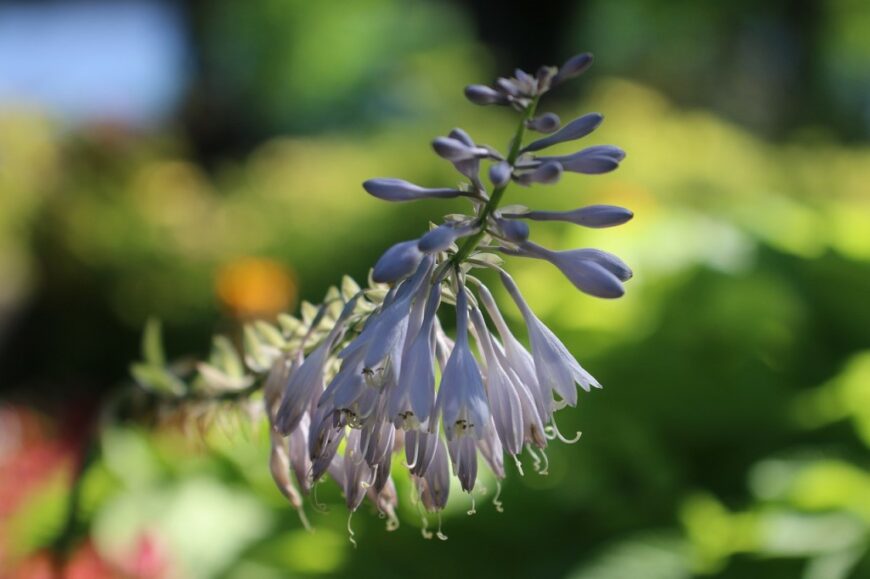
 Name: Hosta
Name: Hosta Family: Asparagaceae
Family: Asparagaceae Origins: Japan, China, and Korea
Origins: Japan, China, and Korea Humidity: High humidity preferred
Humidity: High humidity preferred Location: Partial to full shade
Location: Partial to full shade Soil: Slugs, snails, and fungal diseases such as leaf spot and crown rot
Soil: Slugs, snails, and fungal diseases such as leaf spot and crown rot Pests and diseases: Water regularly, fertilize in the spring and summer, prune as needed, divide every 3-4 years to maintain plant health
Pests and diseases: Water regularly, fertilize in the spring and summer, prune as needed, divide every 3-4 years to maintain plant health Care: Water regularly, fertilize in the spring and summer, prune as needed, divide every 3-4 years to maintain plant health
Care: Water regularly, fertilize in the spring and summer, prune as needed, divide every 3-4 years to maintain plant health Height of growth: 6 inches to 3 feet, depending on variety
Height of growth: 6 inches to 3 feet, depending on variety Planting in the soil: Plant in early spring or fall, with the crown just above the soil surface, spaced 18-24 inches apart
Planting in the soil: Plant in early spring or fall, with the crown just above the soil surface, spaced 18-24 inches apart Blooming: Some varieties produce small, insignificant blooms in mid to late summer.
Blooming: Some varieties produce small, insignificant blooms in mid to late summer.Hostas are one of the most popular ornamental plants grown for their attractive foliage. They are native to Japan, China, and Korea and belong to the family Asparagaceae. Hostas come in a variety of sizes, colors, and textures, making them a versatile plant for any garden. They are often used as ground cover or as accent plants in borders and rock gardens.
Types of Hostas
There are thousands of hosta varieties available, with different leaf colors, shapes, and sizes. Some of the most common types of hostas include:
- Blue Hosta: This type of hosta has blue-green leaves and is known for its elegant look.
- Variegated Hosta: This type of hosta has leaves with contrasting colors such as white and green, or yellow and green.
- Miniature Hosta: This type of hosta is small in size and is perfect for growing in containers or small gardens.
- Giant Hosta: This type of hosta has large leaves and can grow up to 6 feet tall.
Growing Hostas
Hostas prefer to grow in partial to full shade, although some varieties can tolerate more sun than others. They thrive in rich, well-draining soil that is kept consistently moist. Plant hostas in the spring or fall, and space them at least 2 feet apart. Water hostas deeply and regularly, and fertilize them with a balanced fertilizer once a month during the growing season.
Planting Hostas
When planting hostas, choose a spot in your garden that receives partial to full shade. Dig a hole that is twice the size of the hosta’s root ball, and mix in compost or peat moss to improve soil quality. Place the hosta in the hole and backfill with soil, firming it down around the base of the plant. Water deeply to help settle the soil.
Watering Hostas
Hostas require consistent moisture to thrive, especially during the summer months. Water deeply once a week or more often during hot, dry weather. Avoid overhead watering, as wet leaves can encourage fungal diseases. Instead, water at the base of the plant with a soaker hose or watering can.
Fertilizing Hostas
Hostas benefit from regular fertilization, especially in the spring when they are actively growing. Use a balanced fertilizer with equal parts nitrogen, phosphorus, and potassium. Apply once a month during the growing season, following the instructions on the package.
Pruning Hostas
Hostas do not require much pruning, but you can remove dead or damaged leaves as needed. In the fall, cut back the foliage to the ground after it has died back naturally. This will help prevent the spread of disease and pests.
Common Pests and Diseases
Hostas are generally pest and disease-resistant, but they can be susceptible to a few common problems. Some of the most common pests that affect hostas include slugs, snails, and aphids. To prevent pest infestations, keep the garden clean and remove any dead leaves or plant debris. You can also use organic pest control methods such as diatomaceous earth or neem oil.
Some common diseases that can affect hostas include powdery mildew and crown rot. To prevent these diseases, make sure your plants have good air circulation and are not overcrowded. Water at the base of the plant, and avoid overhead watering.
Frequently Asked Questions
Can hostas grow in full sun?
Most hostas prefer partial to full shade, but some varieties can tolerate more sun than others. For example, blue hostas can handle more sun than other types, but they still need some shade during the hottest part of the day.
How often should I water my hostas?
Hostas require consistent moisture to thrive, especially during the summer months. Water deeply once a week or more often during hot, dry weather. Make sure the soil stays consistently moist but not waterlogged.
Can I divide my hostas?
Yes, you can divide hostas every 3-4 years to keep them healthy and vigorous. The best time to divide hostas is in the early spring before new growth appears or in the fall after the leaves have died back.
Do hostas attract bees or other pollinators?
Hostas are not known for attracting bees or other pollinators, as they do not produce flowers. However, some varieties may produce small, insignificant blooms that attract some pollinators.
How do I propagate hostas?
Hostas can be propagated through division, leaf cuttings, or tissue culture. Division is the easiest and most common method. Simply dig up the plant and separate it into smaller clumps, making sure each clump has roots and leaves. Replant the new divisions and water well

